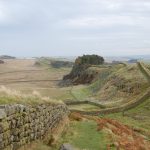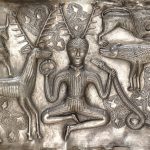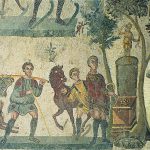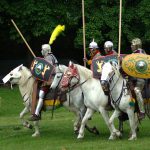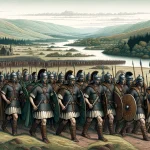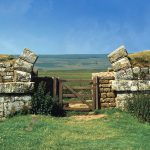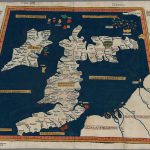Carriden (Velvniate) Roman Fort
Antonine Wall Fort, Marching or Temporary Camp and Vicus
This fort and settlement lies on the southern shore of the Firth of Forth overlooking Torry Bay in Fife, and is situated very close to the eastern terminus of the Antonine Wall at Bo’ness, which lay only a couple of miles to the west. It has been suggested that Carriden and other forts at Cramond and Inveresk formed a chain of forts along the Lothian (southern) shore of the Firth of Forth, perhaps augmented by others as yet undiscovered. This idea is sound, as it would mirror the situation at the western end of Hadrian’s Wall to the south, where a chain of forts and watchtowers have been identified all along the coast of Cumbria, the so-called ‘Western Sea Defences’.
RIB 3503 - Altar dedicated to Jupiter Optimus Maximus
To Jupiter Best and Greatest, the villagers living at the fort of Veluniate (or Velunias), paid their vow joyful and willing, deservedly Aelius Mansuetus taking care of the matter.
Veluniate / Velunia: The place-name Veluniate is probably an ablative of place, and its nominative form is uncertain; as Velunia, it is the first of the ten civitates located by the Ravenna Cosmography in sequence from east to west across the Forth-Clyde isthmus.
Observation from the air in 1945 disclosed at Carriden the defences of the long-lost Roman fort. Photographs record three ditches, forming the defences of the east and part of the south side. The east side was some 440 ft. long, and contained a gate 150 ft. from the south-east angle ; the length of the south rampart appears to have been at least 400 ft. Trial trenches dug in 1946 located the defences on the east side and yielded pottery of Antonine date. The western half of the fort lies within the grounds of Carriden House, while even such part of the site as is available for digging seems to have been heavily denuded.” (St. Joseph, 1951)
Photographs from 1945 showed a triple ditch system on the east and south sides of this fort, which measures roughly 440 ft. from north-south by 400 ft. transversely (c.134 x 122 m), enclosing an area of around 4 acres (c.1.6 ha).
Like many Roman forts in Scotland, Carriden has a couple of marching camps nearby; at Kinglass Park (NT0080) and Muirhouses (NT0180), both near Bo’ness, Central.
RIB 2138 - Centurial stone of Statilius Telesphorus
From the eighth cohort, the century of Statilius Telesphorus (built this).
𐆛 STA
TELES
3. On frequency the nomen is most likely to be Statilius, next comes Statius, and far behind these Staius. Birley (Laur. Aquinc. ii (1941) 55, Roman army (1953) 115) reads Sta(tilius).
The name of this minor settlement was not listed among the four towns attributed to the Selgovae tribe by Ptolemy, but there is classical confirmation of the Roman name for Carriden within the Ravenna Cosmology (R&C#191). This seventh-century geographical work records the entry Velunia – between the unidentified stations Rumabo and Volitanio – which may be rendered in the nominative as Veluniate.
In addition to the Veluniate stone, a Roman dedicatory building inscription has been recovered from the Wall nearby Bo’ness (vide RIB 2139 infra).
RIB 2139 - Distance slab of the Second Legion Augusta
No commentary. Addenda from RIB+add. (1995): Style and execution are discussed by Phillips, PSAS 105 (1972-4), 176-82 with Pl. 9. For traces of red paint in the letters and carving, and a drawing of the cramp holes for inserting the slab into a masonry backing, see Close-Brooks, PSAS 111 (1981), 519-21.
The Dateable Pottery Evidence
The only pottery of note is a piece of samian Form 37 bearing the stamp of Cinnamus, which is dated to the Antonine period.
The Numismatic Evidence
Only 2 coins have been recovered from the Carriden area, an aureus? (possibly only brass) of Vespasian, now lost, and a sestertius of Hadrian found on the ground surface.
References for Carriden (Velvniate) Roman Fort
- The Roman Wall in Scotland by Sir George MacDonald (Oxford, 2nd Ed. 1934) pp.190/191;
- Air Reconnaissance of North Britain by J.K. St. Joseph in J.R.S. xli (1951) p.61;
- The Roman Inscriptions of Britain by R.G. Collingwood and R.P. Wright (Oxford 1965);
- The Roman Occupations of Scotland by B.R. Hartley in Britannia III (1972) pp.1-55;
- A Survey of the Coin Finds from the Antonine Wall by Richard Abdy in Britannia xxxiii (2002) pp.189-217.
Map References for Carriden (Velvniate) Roman Fort
NGRef: NT 0255 8078 OSMap: LR65
Roman Roads near Carriden (Velvniate) Roman Fort
Probable Road: E (11) to Cramond (Edinburgh, Lothian) Antonine Wall: W (3.75) to Kinneil (Central)
Sites near Carriden (Velvniate) Roman Fort
- Muirhouses Camp (1 km)
Marching or Temporary Camp - Kinglass Park Marching Camp (3 km)
Marching or Temporary Camp - Linlithgow Camp (5 km)
Possible Roman Camp - Kinneil Fortlet (5 km)
Fortlet - Inveravon Temporary Camp 1 (7 km)
Marching or Temporary Camp - Inveravon Temporary Camp 2 (7 km)
Marching or Temporary Camp - Inveravon Roman Fort (8 km)
Antonine Auxiliary Fort (AD 138–161) - Polmonthill Temporary Camp (8 km)
Marching or Temporary Camp - Little Kerse Temporary Camp (9 km)
Marching or Temporary Camp - Mumrills Roman Fort (11 km)
Antonine Wall Fort and Marching or Temporary Camp
